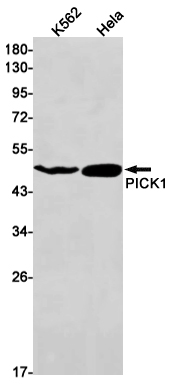
| WB | 1/500-1/1000 | Human,Mouse,Rat |
| IF | 1/20 | Human,Mouse,Rat |
| IHC | 咨询技术 | Human,Mouse,Rat |
| ICC | 技术咨询 | Human,Mouse,Rat |
| FCM | 咨询技术 | Human,Mouse,Rat |
| Elisa | 咨询技术 | Human,Mouse,Rat |
| Aliases | PICK 1; Pick1; PRKCABP |
| Entrez GeneID | 9463 |
| WB Predicted band size | Calculated MW: 47 kDa; Observed MW: 50 kDa |
| Host/Isotype | Rabbit IgG |
| Antibody Type | Primary antibody |
| Storage | Store at 4°C short term. Aliquot and store at -20°C long term. Avoid freeze/thaw cycles. |
| Species Reactivity | Human |
| Immunogen | A synthetic peptide of human PICK1 |
| Formulation | Purified antibody in TBS with 0.05% sodium azide,0.05%BSA and 50% glycerol. |
+ +
以下是3篇与PICK1抗体相关的研究文献及其核心内容总结:
---
1. **文献名称**:*Characterization of PICK1 Antibodies for Detection of Protein Kinase Cα Interactions*
**作者**:Xia J, et al.
**摘要**:该研究通过生成兔源多克隆抗体,验证了PICK1蛋白在大脑组织中的表达及其与PKCα的相互作用,确认抗体在免疫沉淀和免疫荧光中的特异性,为突触蛋白复合物研究提供工具。
---
2. **文献名称**:*PDZ Domain Interactions of the Protein Kinase Cα-PICK1 Complex*
**作者**:Staudinger J, et al.
**摘要**:研究解析了PICK1的PDZ结构域如何结合PKCα的C端序列,并利用抗体在HEK293细胞和神经元中验证了二者的共定位,揭示了其在神经信号传递中的作用机制。
---
3. **文献名称**:*PICK1 Regulates AMPA Receptor Trafficking via Direct Interactions with the Glutamate Receptor 2/3 Subunits*
**作者**:Torres GE, et al.
**摘要**:通过免疫共沉淀和免疫细胞化学技术,证明PICK1抗体可特异性标记与AMPA受体亚基结合的复合物,揭示了PICK1在受体运输及突触可塑性中的调控功能。
---
这些文献均通过PICK1抗体的应用,探索了其在神经细胞信号传导、受体运输等生理过程中的作用,并验证了抗体的实验适用性。
The PICK1 (Protein Interacting with C Kinase 1) antibody is a crucial tool for studying the PICK1 protein, a scaffolding protein involved in diverse cellular processes. Discovered in 1997. PICK1 contains a PDZ domain that binds to C-terminal motifs of interacting proteins and a BAR domain that facilitates membrane curvature sensing. It plays a key role in synaptic plasticity by regulating the trafficking of glutamate receptors (e.g., AMPA, NMDA receptors) and dopamine transporters, linking protein kinase C (PKC) signaling to downstream effectors. PICK1 is highly expressed in the brain, particularly in neurons, and is implicated in neurological disorders such as schizophrenia, addiction, and epilepsy.
Antibodies targeting PICK1 are widely used in techniques like Western blotting, immunohistochemistry, and immunofluorescence to map its expression, subcellular localization, and interactions. They help elucidate PICK1's role in synaptic reorganization, neurotransmitter release, and receptor internalization. Recent studies also explore PICK1's involvement in non-neuronal tissues, including endocrine hormone secretion and kidney function. However, challenges remain in ensuring antibody specificity due to structural similarities with related PDZ-domain proteins. Validated PICK1 antibodies remain essential for advancing research into its therapeutic potential, particularly for neurological and psychiatric conditions.
×